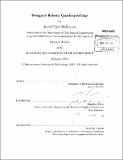| dc.contributor.advisor | Sangbae Kim. | en_US |
| dc.contributor.author | McKenzie, Jacob Elijah | en_US |
| dc.contributor.other | Massachusetts Institute of Technology. Dept. of Mechanical Engineering. | en_US |
| dc.date.accessioned | 2012-04-26T18:54:03Z | |
| dc.date.available | 2012-04-26T18:54:03Z | |
| dc.date.copyright | 2012 | en_US |
| dc.date.issued | 2012 | en_US |
| dc.identifier.uri | http://hdl.handle.net/1721.1/70444 | |
| dc.description | Thesis (S.M.)--Massachusetts Institute of Technology, Dept. of Mechanical Engineering, 2012. | en_US |
| dc.description | Cataloged from PDF version of thesis. | en_US |
| dc.description | Includes bibliographical references (p. 167-171). | en_US |
| dc.description.abstract | Prized for their performance on prepared surfaces, wheeled vehicles are often limited in mobility by rough and unstructured terrain. Conversely, systems that rely on legs have shown promising rough terrain performance but only a modest ability to achieve high speeds over flat terrain. The goal of this thesis is to develop four robotic legs that are capable of robust dynamic running over flat terrain. Demonstration of this ability is necessary to improve the viability of robotic legs as a propulsion system. Achieving true dynamic running presents many challenges, and the first step in prevailing over the difficulties this task presents is the development of a sound mechanical system. The leg designs presented here are based on the development of four design principles from both biological systems, dynamic simulations and previous research. These principles suggest that a leg design should: minimize passive mechanical impedance, minimize mass and inertia, maximize actuator strength and develop a balance between leg kinematics and robot use. To bring these principles into reality several unique design features were introduced including a doubly concentric actuator layout, synthetic fiber tendons to reduce bending loads in the legs, polymer leg links and the use of electric motors to their thermal limit. To accompany these technical features simulation-based design tools were developed that provide an intuitive insight into how altering design parameters of the leg may affect locomotion performance. The key feature of these tools is that they plot the forces that the leg is capable of imparting on the body for a given set of dynamic conditions. Single and multiple leg testing has shown that the legs perform well under dynamic loading and that they are capable producing vertical ground reaction forces larger than 800 N and horizontal forces larger than 150 N. Many of the design principles, features and tools developed may be used with a large variety of leg structures and actuation systems. | en_US |
| dc.description.statementofresponsibility | by Jacob Elijah McKenzie. | en_US |
| dc.format.extent | 171 p. | en_US |
| dc.language.iso | eng | en_US |
| dc.publisher | Massachusetts Institute of Technology | en_US |
| dc.rights | M.I.T. theses are protected by
copyright. They may be viewed from this source for any purpose, but
reproduction or distribution in any format is prohibited without written
permission. See provided URL for inquiries about permission. | en_US |
| dc.rights.uri | http://dspace.mit.edu/handle/1721.1/7582 | en_US |
| dc.subject | Mechanical Engineering. | en_US |
| dc.title | Design of robotic quadruped legs | en_US |
| dc.type | Thesis | en_US |
| dc.description.degree | S.M. | en_US |
| dc.contributor.department | Massachusetts Institute of Technology. Department of Mechanical Engineering | |
| dc.identifier.oclc | 785729031 | en_US |
